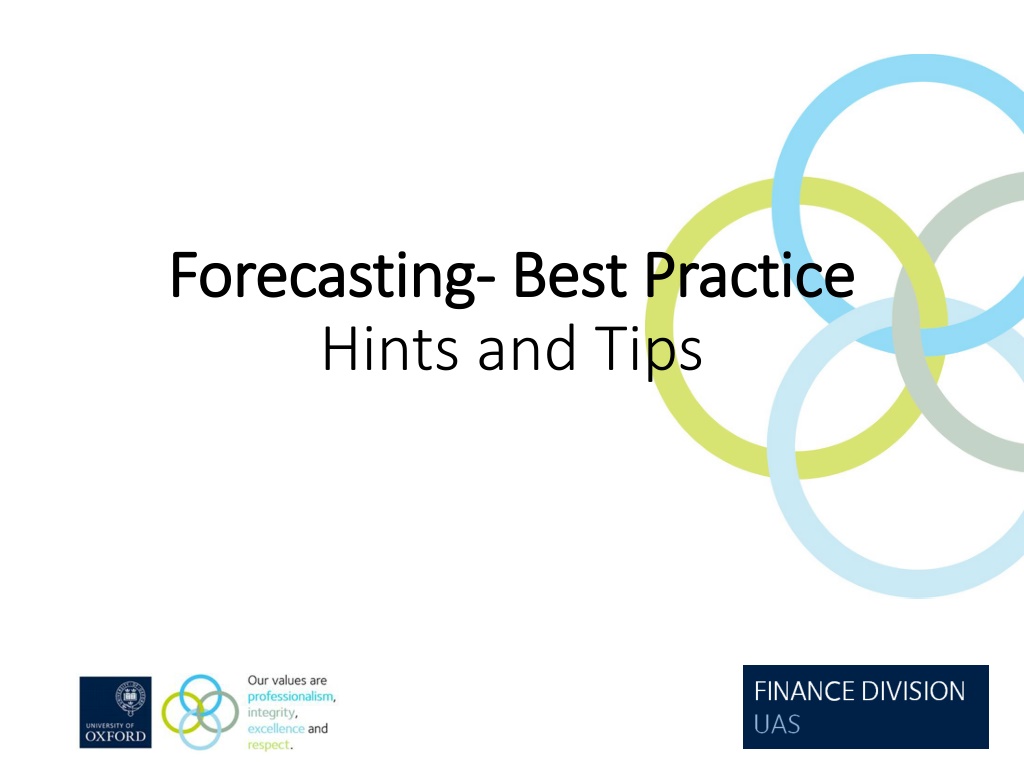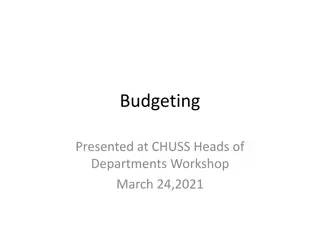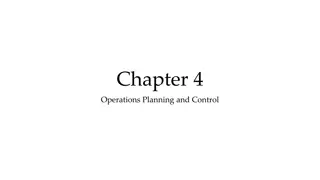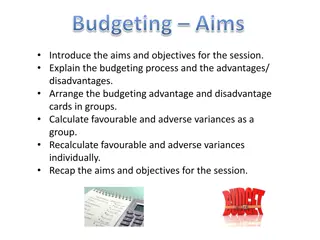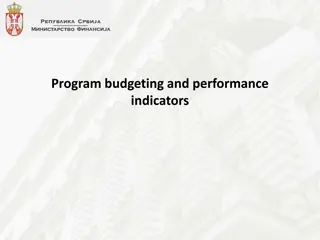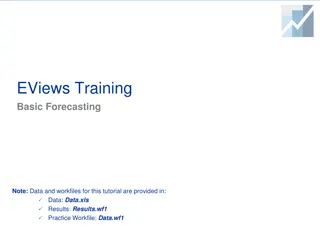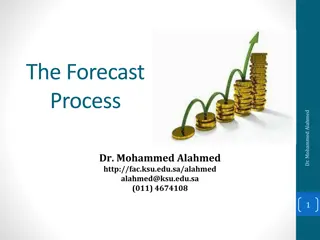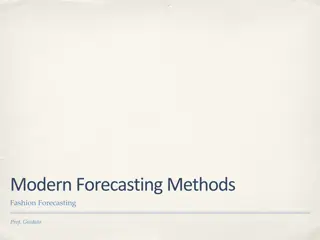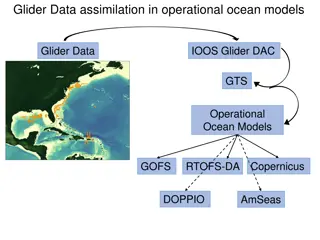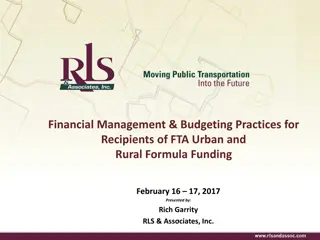Effective Budgeting and Forecasting Practices for Improved Resource Allocation
Understand the key differences between budgeting and forecasting, why they are essential, and where these processes are carried out. Learn about historical forecasting methods, the introduction of the Budgeting and Forecasting Tool (BFT) for increased efficiency, and the importance of BFT reporting in tracking budget variances consistently.
Download Presentation

Please find below an Image/Link to download the presentation.
The content on the website is provided AS IS for your information and personal use only. It may not be sold, licensed, or shared on other websites without obtaining consent from the author. Download presentation by click this link. If you encounter any issues during the download, it is possible that the publisher has removed the file from their server.
E N D
Presentation Transcript
Forecasting Forecasting- - Best Practice Best Practice Hints and Tips
Budgeting and Forecasting- whats the difference? And why do it? Year end 31st July Q1 Aug - Oct Q2 Nov-Jan Q3 Feb-Apr Q4 May - July Year end reporting Q3 Forecast Q1 Q2 Forecast Forecast Budget Preparation Budgeting and forecasting help us to allocate resources effectively and improves decision making Reduces impact of surprises in the system Identifies changes to plans Forms the basis for budgets Highlights areas which may need support or who are delivering above expectations Divisional Offices support the forecasting process
Budgeting and Forecasting- where is it done? The A1 ledger relates to departmental activity and is the focus for budgeting. Forecasting can be done at the Departmental A1 level or cost centre by cost centre. The A2 (departmental projects) and the B ledger (Research) should have a net nil impact on departmental finances as they are funded separately
How did we used to provide forecasts? Forecasts pre 2017 were prepared on multiple worksheets and manually combined at Divisional level Forecasts pre 2017 were prepared on multiple worksheets and manually combined at Divisional level Payroll data Core HR Oracle Actuals General Ledger Multiple Department worksheets Forecast data Combined data
What is the BFT and how did it help? The budgeting and forecasting tool (BFT) was introduced to reduce complexity, increase The budgeting and forecasting tool (BFT) was introduced to reduce complexity, increase consistency, provide reporting and improve links to the Oracle General Ledger and Core HR consistency, provide reporting and improve links to the Oracle General Ledger and Core HR payroll system payroll system
BFT reporting BFT updates with actuals on a monthly basis and so is the best way to keep track of variances to budget even outside of the budgeting cycle
BFT Timelines- What happens when? Q1 3:9 with budget pre-population Basis of preparation Aug Sept Oct Nov Dec Jan Feb Mar Apr May Jun Jul Key review point for re-visiting forecast in light of prior year actuals Act Act Act Bud Bud Bud Bud Bud Bud Bud Bud Bud Q2 6:6 with Q1 forecast pre-population Aug Sept Oct Nov Dec Jan Feb Mar Apr May Jun Jul Q2 is the basis of the budget so needs to be robust Act Act Act Act Act Act Q1 Fcast Q1 Fcast Q1 Fcast Q1 Fcast Q1 Fcast Q1 Fcast Q3 9:3 with Q2 pre-population Aug Sept Oct Nov Dec Jan Feb Mar Apr May Jun Jul Q3 is an early warning for year end issues Act Act Act Act Act Act Act Act Act Q2 Fcast Q2 Fcast Q2 Fcast 11/5 Hard BFT is pre-loaded with all the assumptions you need including pay rates, NI etc
Where is best to start? The approach to starting a Budget or a forecast is similar. Forecasting will be easier as you can use your Budget as a guide. The finance team within a Department would usually coordinate with other key members of staff to gain the level of insight needed to complete the forecast. This could be HAFs, HODs, PIs, building managers etc. Approach your forecast on a line by line basis and use the timetable given by your Division to determine which areas to focus on first.
Staff Costs- a first area of focus Staff costs include: Academic Staff Support Staff Casual & Agency Staff Liaise with your HR contact of Business Manager to check FTE's, noting: Leavers name and role number Starters name, role number, grade and start date Known FTE changes Known Grade changes (not including the yearly incremental increase) Pay awards and increments are put through centrally on BFT so your focus can be on HR changes Check FTE reports available in BFT. These are by individual and by month, providing a comparison to previous forecasts look out or negative FTE's or FTEs greater that 1.0! Investigate cost centres with variances, identify staff members to look at in more detail Analyse variances, correct errors and check changes in the BFT
Staff Costs- BFT Employee Record Card FTE Profile Salary Costs Cost Centre and Account Grade Pension Scheme
Staff costs- Departmental Case Study It is really helpful to catch up with HR to ensure that any changes are captured. This includes new joiners, leavers, distinction awards, maternity/paternity leave and sabbaticals Meeting with the relevant academic heads prior to budget setting helps to identify any new posts that need to be incorporated
Research Overheads Research overheads are an income line that is generated through research activity. These are generated as a proportion of costs on a project to cover indirect costs of research e.g. electricity, building costs, admin support etc. The overhead rates are agreed with each funder and are managed by research accounts. Some projects do not generate any overheads. Each Division has a Research overheads template that is sent out before the relevant reporting quarter. It details the overheads by project, and gives a method of projecting expected overheads. This is based on key dates and figures that pull from Oracle, such as the project end date and the budgeted overheads for each project. This needs to be reviewed and adjusted where the department is aware of potential underspend, project extensions etc. Impacting the overhead recovery for the financial period Awards about to start or awards not yet won are then added to the report to give a complete portfolio. You may wish to adjust these awards to reduce the expected overheads or build in delays depending on the likelihood that they will track as planned.
Research Overheads- Hints and tips In our department we ensure that the Pre-award team is closely involved in assessing our pipeline. We apply a % chance of success to each application depending on how far along the pipeline a project is It may be useful to break the portfolio down into different funder types or awards with similar profiles (mostly salary costs or with large one-off purchases). Then these awards can all be considered together.
JRAM JRAM stands for Joint Resource Allocation Method and allocates out resources across the collegiate University. The main parts of JRAM are: Teaching JRAM 'T JRAM' Research JRAM 'R JRAM' Taxes and transfers Teaching JRAM is supported by a Course Listing and includes the income earnt on all matriculated courses split between department and college. Research JRAM is split between Charity, Business and Quality Related (QR) funding
Trust Funds and Donation Income The University receives income in the form of trust funds and donations An individual or business may give money to the University in the form of a gift or donation. This needs to be assessed and the correct accounting treatment given. New donations can be difficult to predict but any deferred gifts already received should be included in the forecast to match spending. Trust funds are held centrally by the University and reports sent to Departments regularly. These can be used to match expenditure. Any relevant spend included in the forecast should show matched income from the trust fund. The reports from central finance can be used to determine how much money remains in each trust fund.
Other Income Source of Funds The University GL Account String is made up of: Cost Centre Account Activity Source of Funds Organisation Future XX1234 12345 12 X1234 (default 00000) 12 000000 Source of Funds (SOF) codes can help identify your department's unique income sources. Both income and expenditure can be coded to SOF codes and this is mandatory in relation to trust funds and donations (Bxxxx & Cxxxx Codes) SOF codes are organised in groups depending on their use; the first letter of the code indicates which group it belongs to: Axxxx = Medical Funding Bxxxx = Trust/endowment Cxxxx = Donations Dxxxx = Specific HEFCE funding Fxxxx = Scholarships Mxxxx = Examination Boards Pxxxx = Other income analysis Sxxxx = Departmental analysis They are simple to set up and can be used as parameters when running reports For a list of all existing SOF codes use this link and navigate to the chart of accounts https://finance.admin.ox.ac.uk/useful-documents-for-oracle-financials
Other Expenses Other expenditure lines may include building costs, training, travel etc. It can be useful to look at historical information and look at normal run rates for building costs and utilities. For staff related costs, there may be plans for travel or conferences that will need to be considered in more detail Grants the grants line may include various forms of student costs. Departments may need to consult with their student services teams to determine what costs are expected.
Supplies and Equipment Type of Asset Life (years) Item Cost Accounting Depreciation the cost of the asset is charged to the I&E in equal monthly instalments spread over the life of the asset monthly amount charged to the expenditure account across the whole asset life 60k >1 Fixed Asset The entire cost is charged to the GL in the period of purchase Expense Asset 20k >1 N/A Externally Funded Equipment Purchases income is fully matched to equipment cost in the month of purchase via a Trust Fund This is done centrally and will not affect your GL 60k >1
Depreciation of a 50k fixed asset - Departmental Case Study A Department buys a microscope for 50k in May. The item is categorised as equipment and is depreciated over a period of 5 years (60 months). As the date placed in service is May, there will be 3 months depreciation charged in the first year. In the sixth- year depreciation with stop in April when the 60th month of depreciation is charged.
Supplies and Equipment Department Responsibilities Make sure you code equipment purchases correctly Liaise with the central Fixed Asset Team to ensure internally funded asset details are correct Check asset capitalisation information (DEL) provided by the Fixed Asset Team Budget and forecast for existing assests in BFT for depreciation of capitalised assets using the (DEL) and for planned assets contact your divisional finance team Fixed Asset Team Process Fixed Asset Team picks up asset details on a monthly basis after the Accounts Payable and Projects module close (close of WD2) Fixed Asset Team journals capital adjustments by WD6 The first month of depreciation is charged to the GL in that month and every month for the remaining life of the asset Departments are sent a report showing Oracle accounting entries for the capitalisation adjustments made The DEL is issued quarterly, listing all department assets (regardless of capital treatment or funding)
Take a step back and consider.. Do the total movements align to my understanding? Does it make sense against actuals? Does it make sense against the last budget/forecast? Do my A2 and B ledgers net to nil? Do my income and expense lines look sensible line by line? Have I captured everything that I have discussed in the department? Does my FTE total look correct? Do I have any 'negative' people? Is my phasing by month as accurate as possible?
Your Division is here to help JRAM balances Continuation charges and Visiting Student budgets Research templates Trust Fund balances Service Charge, Space Charge & Contribution Divisional recharges
Where does the forecast go next? The forecast is used by different committees for different purposes Finance Committee & Council Department Division PRAC Manage expenditure and reallocate resources if necessary Identify risks and opportunities Consider impact on University wider resource allocation and delivery of the strategic plan Consider impact on University strategy, risk and financial sustainability
Useful links and who can help BFT: IBM Cognos TM1 Web (ox.ac.uk) BFT 'How To' training clips: BFT Training "How To's" | Finance Division (ox.ac.uk) BFT Training map: BFT Training | Finance Division (ox.ac.uk) Budget guidance notes are refreshed annually and include key budget assumptions: https://finance.admin.ox.ac.uk/files/2023-24budgetassumptionsguidancedocx Your Divisional Team are a great starting point- if they don't know they will know who to ask BFT support is available here (BFTSupport@admin.ox.ac.uk) but liaise with your Divisional Team first.
